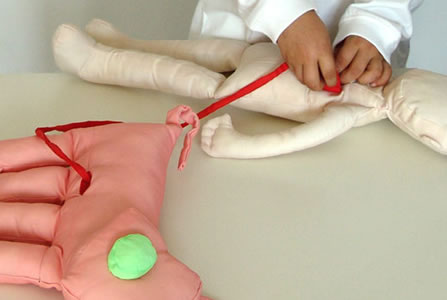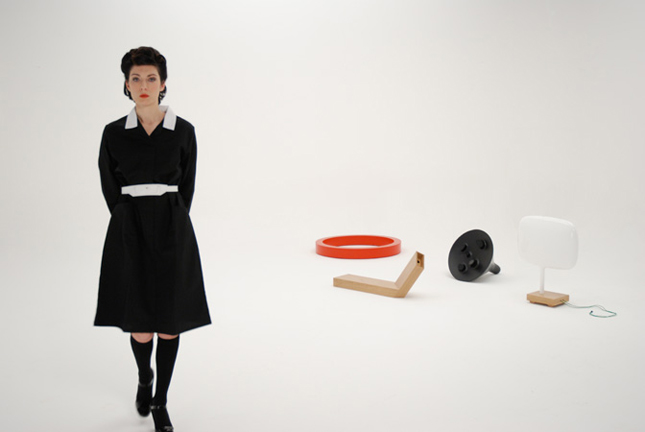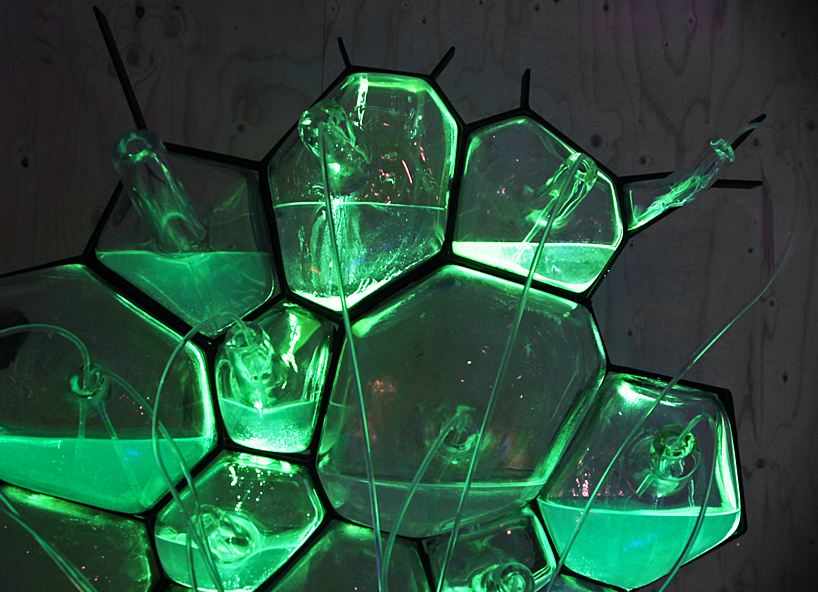Product design aims to improve efficiency, comfort, and experience, and it surrounds us in our anthropocentric world. Within the past few decades, a relatively new approach to design has emerged, allowing designers to consider beyond the wants of the present day and design critically about the future. Dubbed “Speculative design,” this area of work considers the problems which product design, until this point, has not been able to effectively address. It promotes a fictitious approach, and it invites designers to create without the constraints of present-day problems in order to conceptualize the problems we may face in the future.
Speculative work does not seek a market, but instead relies on form and function to communicate a concept and explore a possible future. These designs can be shocking, dark, and unnerving in order to communicate radical ideas about the future landscape of design. Conflicting images such as Anthony Dunne and Fiona Raby’s Huggable Atomic Mushrooms are designed to make people more comfortable with nuclear annihilation. This project quickly instills a sense of distress about a future in which nuclear weapons are instead literally embraced by people to put them at ease with their reality (Dunne & Raby, 42). Similarly, Mybio Dolls by Elio Caccalvale explore the ethical questions of a world in which hybrid animals are more common. Caccalvale illustrates this theory through a collection of children’s toys which are intended to make people more comfortable with the idea of new animal hybrids (MoMA). The project features images of children playing with the toys that depict the honest reality of our evolving relationship with animal products. The project provides striking, even disturbing visuals to bring into question a possible future like this.

Elio Caccalvale Mybio Dolls
“Dark design is not pessimistic, cynical, or misanthropic; it is a counterpoint to a form of design that through denial does more harm than good. Dark design is driven by idealism and optimism, by a belief that is possible to think our way out of a mess and that design can play an active role.” – Dunne & Raby, 43
Even given the growing popularity of speculative design within the design community, speculative or critical products are rarely (if ever) found on shelves. Speculative works often exist only in a gallery setting, and are viewed by a select, academic group. Dunne & Raby attempt to address this fact through projects such as their 2001 Placebo Project in which they gave their pieces to volunteers for testing and then gathered feedback on the effectiveness of their designs. Taking projects out of the gallery to live as they would in the real world leads to more information throughout the design process, culminating in a more tangible result (Dunne & Raby). Short run projects such as the Placebo pieces will only be interacted with by a very small number of people. Nonetheless, Dunne & Raby help to illustrate that for Speculative design to have an influence on human behavior, it needs to reach beyond a gallery.

Dunne & Raby Placebo Project
In academic settings, critical design has become a necessity for a well-rounded design education. It introduces a radical new way of thinking, and allows students to generate and understand their values as designers. Imagining futures and visualizing how your products can play a role in those futures is a responsible and sustainable approach to design. In the article Design Futuring, Tony Fry calls attention to this pivotal moment in time, our overwhelming effects of our species on the environment, and the general lack of ethics in design (Fry, 2-4). He suggests that a common approach to product design is “human centered,” and it is not about thinking at a large scale or over a long timeframe, but is about immediate impact in the consumer world (Fry, 2).
Giving students of design a tool to think about the ethics of their work at the very start of their career leads to more sustainable practices and understandings of the sacrifices made for the present. Such potential within education coupled with a hollow market facing this type of discursive work pulls designers such as Dunne & Raby to colleges. Until recently, both Dunne & Raby were associated with The Royal College of Art (RCA), which was the major hub of speculative work. Here, they lead the Design Interactions department, imagining how things could be, instead of how things are. (Antonelli).
“RCA Design Interactions curriculum: amplify human rituals and habits using contemporary technology, high production values (the works are usually presented not only as objects, but also as perfectly crafted short films, performances and/or visuals), and a strong philosophical stance about possible and preferable futures.” – Paola Antonelli
Their RCA program emphasized theoretical approaches, alternative futures, and encouraged the connection with scientists and advocates in order to better spark discussion, to produce projects informed by advances in technology and biotechnology (Dunne & Raby, 57). Projects such as Dunne & Raby’s All the Robots, Chanel Four’s series Black Mirror, and Emily Hayes’ Manufacturing Monroe all depict futures which have reached the goals held by many technology companies today. In these imagined worlds robots live with us, we ride stationary bikes to harness energy and live in screen-rooms, and we are able to recreate our favorite stars bit by bit.

Dunne & Raby All the Robots
Many schools, including RISD, approach critical work from different angles. Within RISD ID, the term speculative design is not introduced until about 3 years into the program, and even then is used generally. “Speculative work” is used in many ways to classify all future-oriented design projects regardless of its purpose or concept. The common question of “what problem are you trying to solve with this project” from professors makes conceptual or critical thinking within RISD ID very limited.
Speculative work is not attempting to provide answers to design problems, but instead is asking questions about the future. It uses concepts and means of execution which at times can be more similar to “art,” but it places the pieces in “believable everyday situations so that we can explore possible consequences before they happen” (Dunne & Raby, 57).


Philips Microbial Home
A similar strategy of speculation and imagining possible futures is also evident in innovation labs with a a friendly and strictly “optimistic” spin. Small divisions of companies such as IKEA and Phillips are imagining the way their companies may look in the future. Products such as the Philip’s Microbial Home imagined the look of a “perfect,” sustainable, domestic kitchen (Dunne & Raby, 28). Features such as their algae, bioluminescent light and their outdoor urban beehive present striking visuals, but will doubtfully ever be put into production. These projects introduce new values into the production and design of domesticities, and serve as a valuable marketing tools which demonstrate the consideration for the company’s future (DesignBoom). Whether or not the products are intended for production, the strange and futuristic aesthetic coupled with the radical function suggests that companies like Philips are leaders in innovation.

Space10 Tomorrow’s Meatball
Similarly, IKEA recently opened a new innovation lab in Copenhagen, Denmark. Here, a group of designers and artists are exploring the potential future of IKEA and their market dominance by recreating iconic IKEA products such as their meatballs with a priority placed on sustainability. Every day, approximately 2.2 million meatballs are sold every day at IKEA stores around the world (Sweden). To propose a new approach to making and marketing this product, Space 10 collaborated with chefs to visual the meatball of the near-future. These included meatballs made of plants, artificial meat, waste-food, mighty-powered (food supplements), and rapidly growing algae (Space 10). These products are all shown in beautiful photos with lovely colors and textures, but the balls have an underlying gross factor. One of the most iconic balls from this project is made from insects which contain less fat and more protein than most meat options. Despite these advantages, the image of food covered with bugs is still far from edible for most.
The meatballs were circulated throughout the design departments of IKEA in hopes of sparking new approaches to projects. The project and even the studio of Space10 became very popular on many design blogs. With white walls, modular furniture, and groups of very hip looking people, the entire lab gave off a great future feel. IKEA’s attempts (even if just for internal-circulation) to produce more sustainable options in the face of accumulating global waste, helps to reaffirm their position as a leader within their market.
“As change has to be by design rather than chance, design has to be in the front-line of transformative action. But for design to be able to perform this role, the sum of all design practices, including architecture, themselves have to be redesigned.” – Tony Fry, 6
Unfortunately, even these more accessible, large scale, and popular projects like the Space10 hacks are still relatively near-future and often watered down to appeal to a broader market. They may not seek an immediate return, but they undergo a beautification process and are rendered less extreme to afford possible mass-production. An emphasis on marketability and comfort is also evident in such work as Buckminster Fuller’s Dymaxion House. This futuristic spaceship-home has a dramatic exterior which challenged traditional conventions of what a domestic home should be. It asked people to reconsider their priorities within this personal space, and what design and engineering’s roles should be. Despite the speculative, future-thinking exterior, the interior was decorated with comfortable, familiar home pieces.

Buckminster Fuller Dymaxion House
Design futuring has the potential to lead us out of our anthropocentric world. It challenges us to think about the future and our responsibilities as designers as we strive for sustainability. We are moving into an age in which product design may be seen as a symbol of our over consumption. In preparation, product designers must be able to anticipate scenarios to ensure the creation of sustainable goods and services. Designers must be present as creative leads at the beginning of a project, rather than as an aesthetic consultant at the tail end of a venture. Radical ideas and speculation have the capability to inform the strategy of businesses from the start, and to create a positive economic, environmental, and social impacts as a result.
Works Cited
Antonelli, Paola. “States of Design 04: Critical Design.” Domusweb.it. N.p., 31 Aug. 2011. Web. 29 Apr. 2016.
Dunne, Anthony, and Fiona Raby. “Dunne & Raby.” Dunne & Raby. N.p., 2001. Web. 29 Apr. 2016.
Dunne, Anthony, and Fiona Raby. Speculative Everything: Design, Fiction, and Social Dreaming. Cambridge, MA: MIT, 2013. Print.
“Elio Caccavale, Richard Ashcroft, Queen Mary, University of London, Michael Reiss, Institute of Education, University of London. Xenotransplant, from the Hybrids: Towards a New Typology of Beings And, Animal Products ProjectMyBio Xenotransplant (Prototype). 2005 | MoMA.” The Museum of Modern Art. N.p., 2016. Web. 29 Apr. 2016.
Fry, Tony. Design Futuring. N.p.: Berg, 2009. Print.
“Philips Eco Friendly Microbial Home.” Designboom Architecture Design Magazine Philips Eco Friendly Microbial Home Comments. N.p., 02 Nov. 2011. Web. 29 Apr. 2016.
“Quick Fact: IKEA | Sweden.se.” Sweden.se. N.p., n.d. Web. 29 Apr. 2016.
“Tomorrow’s Meatball: A Visual Exploration of Future Food.” Space10. N.p., 9 Dec. 2015. Web. 29 Apr. 2016.

This was a really interesting read, especially as someone who is entering the product and furniture design world for the first time and is constantly baffled by why so many inferior projects exist. Your comments on IKEA are particularly interesting, and I looked up Space 10 after reading this. It’s really a brilliant move by IKEA to make this a project, even just for marketing reasons. IKEA and their furniture now appears so “big ubiquitous company” with their giant blue store everywhere, and they don’t make a show of individual designers and individual voices in the corporation. Space 10 shows that IKEA is trendy, up with the present and already thinking about the future. It is an incredible small space comparatively, with massive windows that let people look in at “designers making the world a better place.” It’s also amazing how many good press photos are available of the space, with people posing perfectly (hard at work, constantly designing); they must really have wanted this to the public face of what IKEA is, even though in reality it is just a side show. IKEA, however, uses massive amounts of wood every year, and is the single largest consumer of wood products. Space 10 is trying to remind that consumer that that isn’t important.
LikeLiked by 1 person
This branch of making and thinking seems the most radical, but in a way the most productive, because it’s focus is not hindered by the concerns of the present or marketing, branding, and the whims of the consumer. The consideration of the future isn’t just a step of the process, it is the focus of the entire endeavor.
Embracing potentially dark futures may serve the present more than we realize. I think that speculative design should be discussed and studied more in depth in design schools like RISD, because it’s mindset seems to be becoming increasingly relevant. As you noted, “we are moving into an age in which product design may be seen as a symbol of our over consumption.” What I question is whether speculative design and product design can remain separated for much longer. Does the reason speculative design never go beyond galleries and academic settings is because it has no commercial aim? It would be too controversial to actualize? Is it meant to remain speculative? Regular commercial designers don’t think long term enough; they think about the commercial longevity, the user longevity, but not holistically enough about the world they are designing for. Can the aims of these hypothetical designs work with the mainstream designers to figure out how to solve problems? Designers may learn from the ambitions of speculative design, its investment in the future and how to think about what they design creates patterns of behavior that outlast the initial product. Patterns of change need to also be redesigned and be adaptable. Products, theories, and projects influence each other’s evolutions, and this power needs to be harnessed.
LikeLiked by 1 person
This was a really good read Molly, and your mentions of the Mybio Dolls, IKEA meatballs and Philip’s futuring campaigns are all good examples of designers looking to effectively start a conversation.
In order to get a point across and resonate with an audience, “dark futuring” and sobering imagery/content is necessary for speculative design to have any impact. I agree with your comments of speculative design and its place within the ID department. Discursive design seems to be undervalued in our department, and the notion that everything needs to be solving a problem comes across as pretty set-in-stone by much of the faculty. We are being taught a lot about manufacturing processes and take skill-building courses, and we rave about the future in terms of CNC’ing and augmented reality, but when it comes to designing for third world countries, speculating on where the world is heading, there is very little discussion. And a lot of speculative work that comes out of our department is seemingly self-driven. I think in order for this kind of design to gain more traction, there needs to be more cross disciplinary thinking between departments, with a more concentrated effort towards educating students on the current state of low wage workers, environmental issues, negative effects of design practices, etc.
I also think that one of the limitations with speculative design is that if it doesn’t offer some guidance to the audience of how they can help in some sense, the content can be diluted. If the viewer’s take away from speculative design is an accepted reality complex, meaning that it’s too late to make a difference, or “we’re screwed” attitude, how effective is the message behind the piece?
LikeLike
I like the last part of Luke’s comment. A big sell for speculative design is that it informs future design decisions by collecting responses to speculation. Most people don’t see that part of the process though, because if a speculative designer wants to collect responses to their work, they have to reach out to a specific group on their own, through media or direct communication. This presents a few problems: the responses are self-selecting or cherry picked by the designers, the responses may not be from a large enough group, the research may be conducted unprofessionally. The overarching dilemma is that if creative companies want to include large groups of people in decision making, then they need an official platform for gathering responses for possible future institutional initiatives. Without a reliable way of gathering unbiased feedback, a speculative designer is more of a forecaster than a researcher.
LikeLike
This was a great post and contained good examples of the variety of directions of speculative design. I enjoyed your attempt to deconstruct the massive and general category of speculative ventures into more specificity; design intending to anticipate and provide future solutions and design intended to raise questions and promote reconsideration. Admittedly there is a great deal of overlap between the two, but those two extremes are important to understand for their differing motivations. I can’t help but consider the sponsored projects and glossy presentation as attached to the curated public perception these companies try to foster as much as they are connected to a desire to change. Projects like Tomorrow’s Meatball do promote meaningful discussion the extent to which they exist as original proposals versus clean repackaging of existing concepts is blurry. And this is not necessarily a problem as they act a vehicles to distribute important ideas to more of a public requiring a high standard of consume-ability. Perhaps the nature of the field is for the wide variety of discursive works to exist until the adequately digestible or closest-to-real can be re-represented through professional presentation.
LikeLike